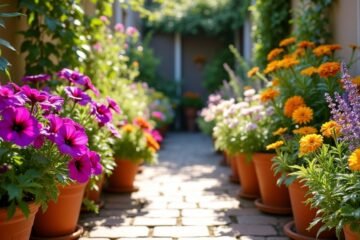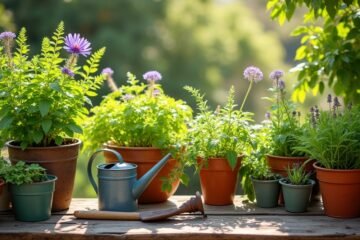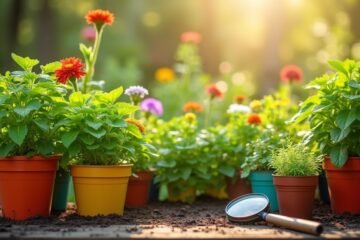Soil selection’s the secret sauce for your container garden‘s success! It affects everything from plant health to growth speed, just like a cozy bed helps you sleep better! A lightweight mix enhances root exploration, while peat moss keeps your plants hydrated like a rejuvenating drink on a hot day. Plus, the right soil offers a perfect balance of water retention and drainage. Want to transform your pots into vibrant oases? Stick around—there’s more to discover!
Understanding the Importance of Soil Quality
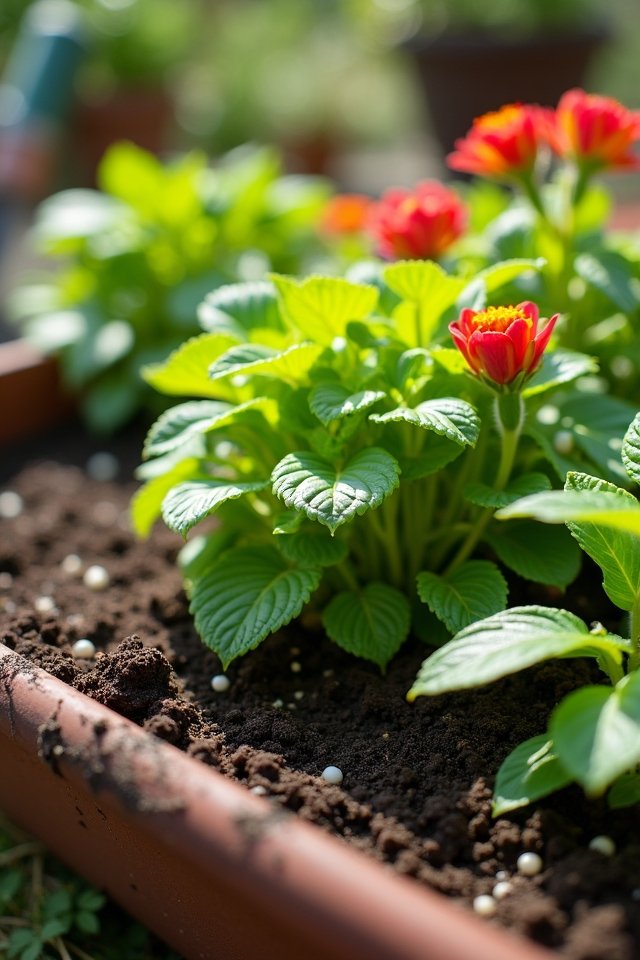
When it comes to growing beautiful plants in container gardens, soil quality is everything! Imagine your plants delighting in the perfect soil texture, like a soft blanket that cradles their roots. High-quality soil boosts microbial activity, creating a lively underground network that feeds your plants and keeps them thriving. When you give them this rich environment, it’s like throwing a party with gourmet snacks for your green buddies. Don’t skimp on this crucial ingredient—after all, it’s the foundation of your gardening success! A well-balanced mix guarantees moisture retention and drainage, keeping your plants happy and hydrated. So, get that ideal soil ready! You’ll be amazed at how your container garden transforms into a vibrant oasis that turns heads!
The Components of Ideal Container Soil
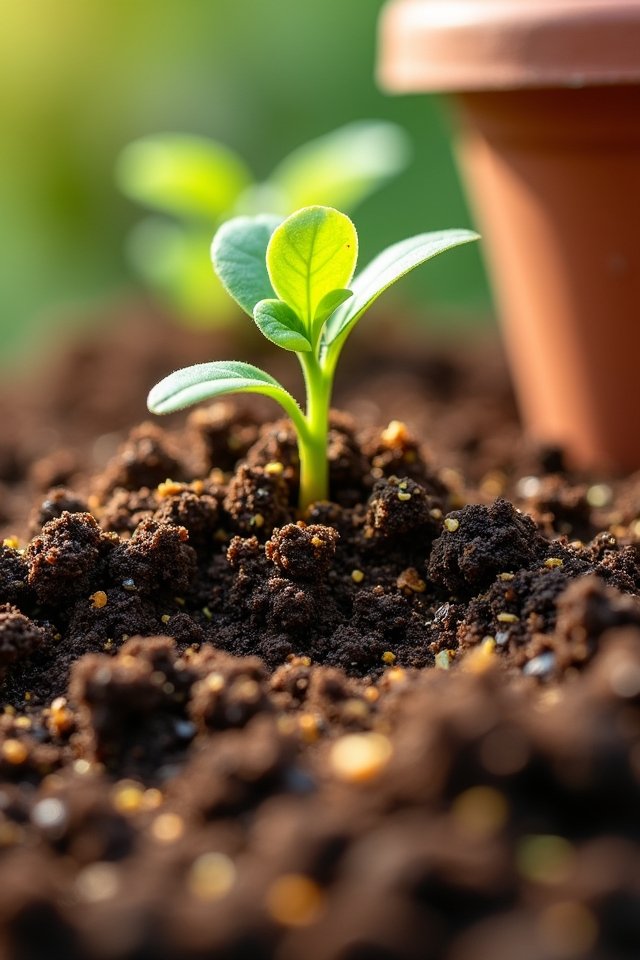
To create the perfect container garden, you’ve got to think about what’s going on inside that pot! The right soil components are the magic ticket to success. You want a mix that promotes healthy growth and makes your plants feel special. Here are three essential ingredients:
- Lightweight Potting Mix – This helps with soil texture! Think of it like a fluffy cloud your roots can explore.
- Peat Moss – This champion boosts moisture retention, keeping your plants quenched and happy.
- Perlite or Vermiculite – These little wonders improve aeration, ensuring your plants breathe easy.
When you combine these ingredients, you create an inviting environment for your greenery. So, get creative and give your plants the great home they deserve!
How Soil Affects Water Retention and Drainage
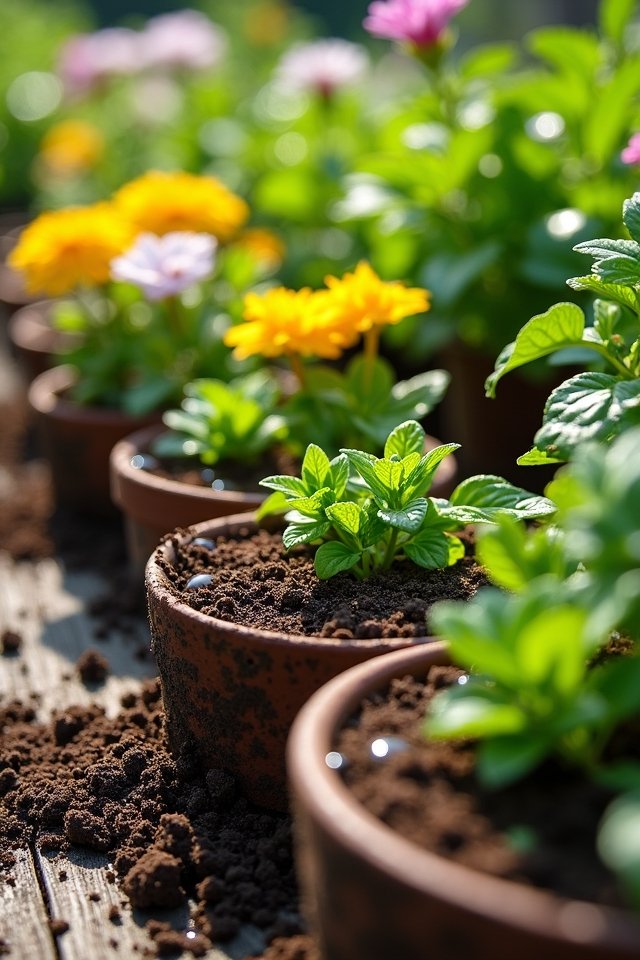
Soil can make or break your container garden, affecting how well water stays put and how easily it drains away. Think of your soil as a cozy sponge—some hold water like a champ, while others run dry too quickly! The perfect mix offers a drainage balance, letting excess water flow out while keeping enough for thirsty roots. You want a blend with compost, coconut coir, or perlite, which improves water retention without drowning your plants. A great example? A well-draining potting mix that maintains moisture after a rain. Remember, too much sogginess spells doom for roots! So, choose wisely, and watch your garden thrive like a superstar in the spotlight! Who wouldn’t want that?
Nutrient Availability for Container Plants
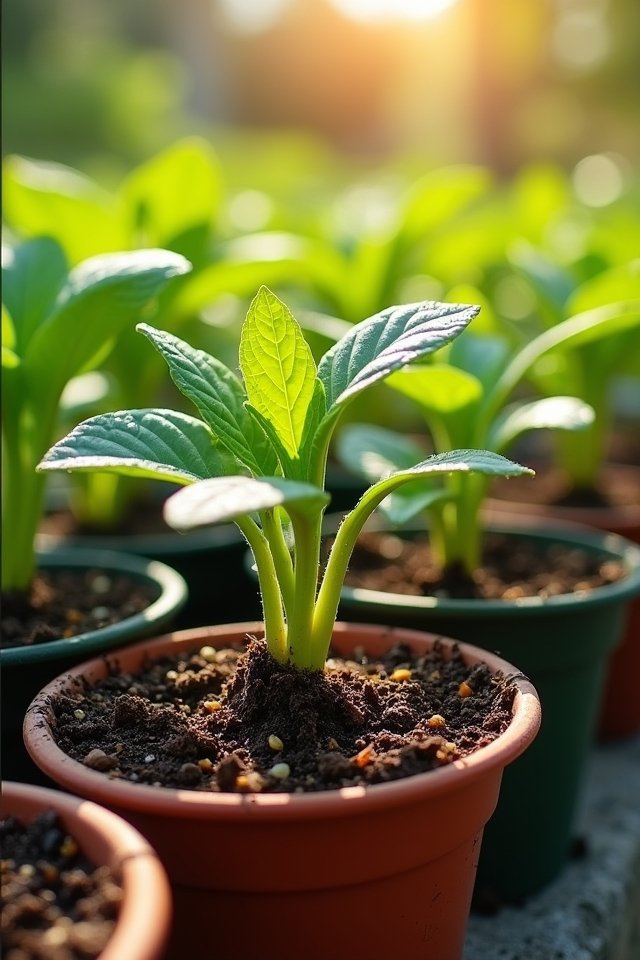
Even the sunniest day won’t help your plants thrive if they aren’t getting the nutrients they need! You might think soil’s just dirt, but it’s alive with microbial activity that’s essential for nutrient cycling. Here’s what you need to know:
- Choose Quality Soil: Look for mixes with organic matter, which boosts microbial life.
- Feed Your Plants: Use slow-release fertilizers to guarantee a steady supply of nutrients over time.
- Monitor Nutrient Levels: Test your soil—don’t let your plants suffer a deficiency!
Trust me, a little care in nutrition means you’ll see greener leaves, vibrant blooms, and fruits bursting with flavor! You’ll end up with a thriving container garden that makes you smile every time you peek outside!
The Impact of Soil Ph on Plant Growth
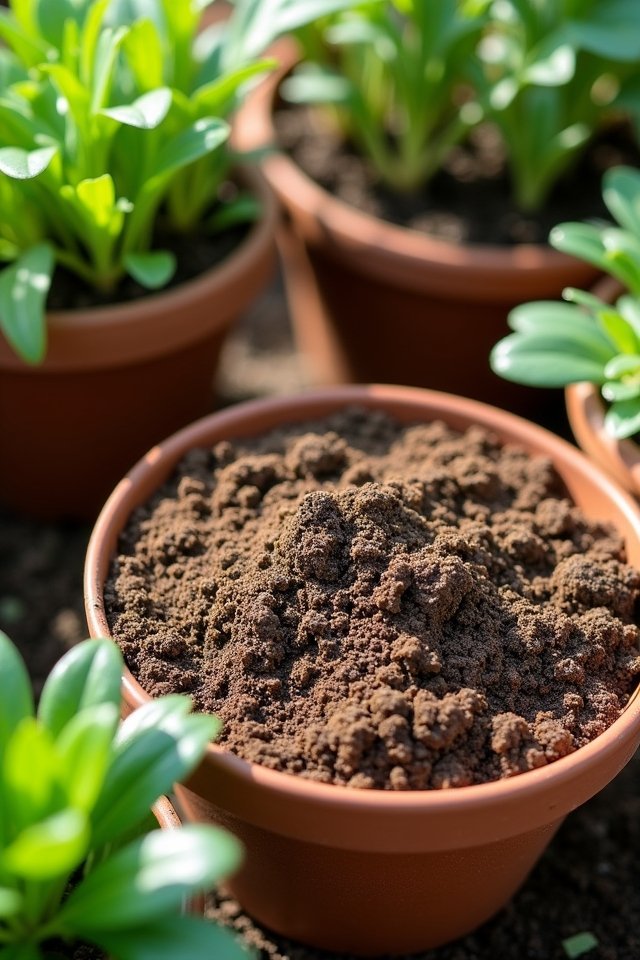
When you’re nurturing your container garden, it’s easy to overlook one sneaky factor that can make or break your plants: pH levels! Soil acidity plays a critical role in plant health. If the pH isn’t just right, your plants might feel like they’re wearing shoes two sizes too small—uncomfortable and stunted! Ideally, most plants thrive in slightly acidic to neutral soil, around 6.0 to 7.0 on the pH scale. Too low or too high? It can lead to nutrient lockout, making your beloved greens lean and unhappy. So, why not test your soil? You’ll save yourself the heartache of watching droopy leaves and yellowing shoots. Happy plants equal happy gardeners! Isn’t that a winning formula?
Common Soil Mixes for Container Gardening
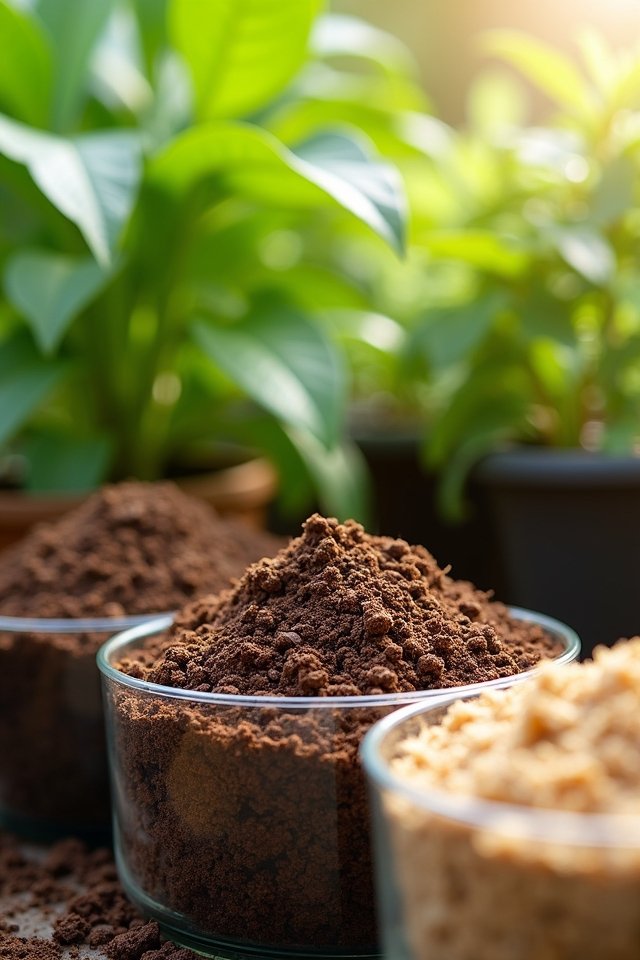
You might be surprised to learn that not all container gardens need the same type of soil mix! Choosing the right combination can transform your garden from average to extraordinary. Here are three popular mixes to take into account:
- Peat Moss & Perlite Options: This mix breathes well, allowing roots to thrive, just like a cozy sleeping bag!
- Coconut Coir & Compost Blends: This duo retains moisture while enriching nutrients. It’s like a delicious buffet for your plants!
- Vermiculite Benefits: Adding this lightweight wonder gives your soil extra aeration, making it puff up like a fluffy cloud!
Ready-made mixes are convenient, but homemade recipes let you customize! Just don’t forget soil sterilization for peak health—your plants will thank you!
Organic vs. Synthetic Soil Amendments
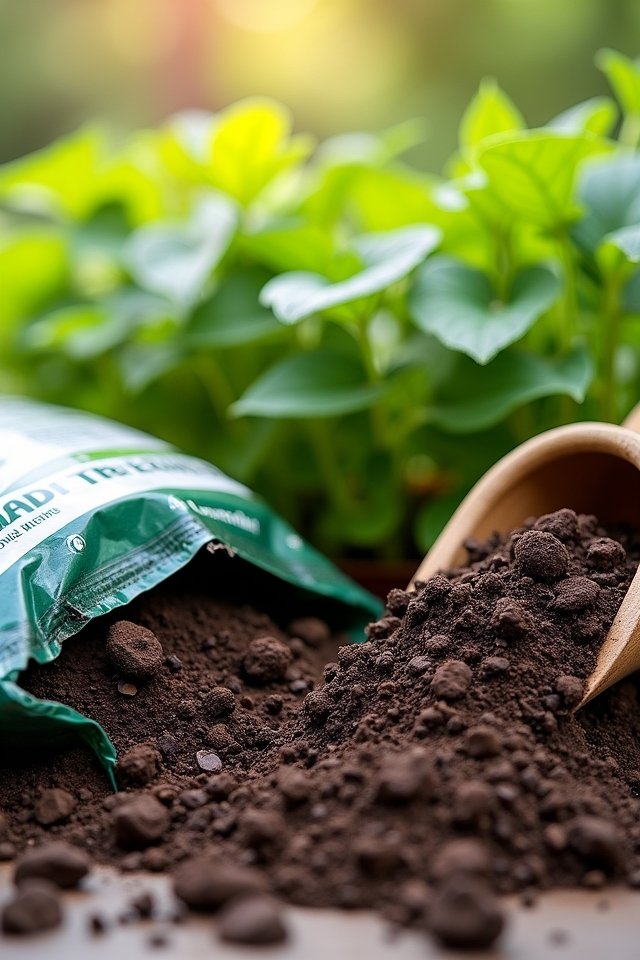
While you may think all soil amendments are created equal, the reality is that choosing between organic and synthetic options can feel like charting a maze of choices. Organic fertilizers are like the gentle hug your plants crave. They enrich the soil, improving structure and fostering beneficial microbes. Imagine your garden bursting with life! On the other hand, synthetic additives can be the quick fix—like a caffeine jolt for your plants. They deliver nutrients fast, but they can also harm your soil’s ecosystem over time. So, which do you pick? If you’re after a thriving, sustainable garden, informative dialogues regarding these choices can guide you towards thoughtful decisions that resonate with your eco-conscious heart!
Tips for Maintaining Soil Health in Containers
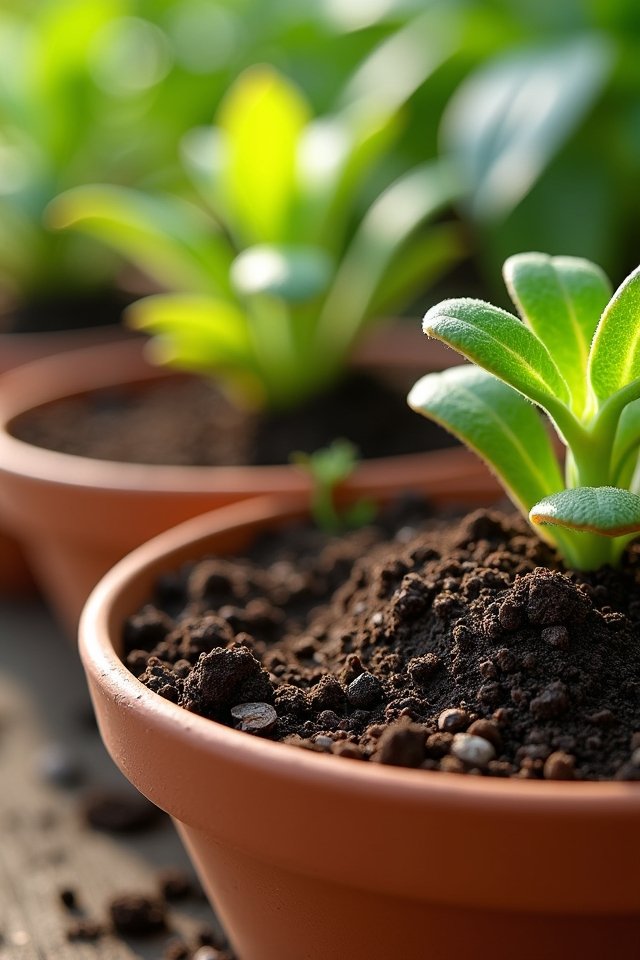
Four key tips can keep your container garden’s soil as happy as a clam! Think of your soil like a living organism—it craves attention! Here’s how to keep it thriving:
- Embrace compost benefits: Add rich compost to provide nutrients and improve soil structure. It’s like giving your plants a gourmet meal!
- Master mulching techniques: Use organic mulch to retain moisture and suppress pesky weeds. Think of it as a cozy blanket for your plants, keeping them snug and warm.
- Rotate plants: Change up what you grow each season. This promotes diversity and keeps pests guessing, just like mixing up your workout routine!
Frequently Asked Questions
Can I Reuse Soil From Previous Container Plants?
Absolutely, you can reuse soil from previous container plants! Just remember, it’s not like dusting off an old book. Over time, that soil can face nutrient depletion, so it needs some love. Try soil rejuvenation techniques, like mixing in fresh compost or worm castings. It’s like giving your garden a yummy meal! So, grab your shovel and reenergize that soil! Your new plants will thank you with vibrant colors and lush growth!
How Do I Know if My Soil Is Contaminated?
Did you know nearly 40% of urban gardens face soil contamination? Yikes! To check if your soil’s contaminated, start with soil testing kits available online or at garden stores. You might find lead, pesticides, or even fungi lurking in your dirt! Ugh! Sources of contamination include old paint, construction debris, and improper disposal of chemicals. Keep your plants safe and thriving—don’t skip the test! Your green oasis deserves fresh, clean soil!
What Are the Signs of Poor Soil Quality?
Signs of poor soil quality can really dampen your gardening spirit! If the soil texture feels gritty like sandpaper, that’s a red flag! Nutrient balance is key; if your plants are yellowing or just wilting away, it’s time to investigate. Look for clumps that don’t crumble easily—like hardening clay! Smell can help too; a sour odor screams problems. So, get your hands dirty and check that soil—you want it happy and healthy!
Can Different Plants Share the Same Soil Mix?
Different plants can share the same soil mix, but you’ve gotta consider plant compatibility! Some plants thrive on the same soil nutrients, like potting mixes made for herbs and veggies. For instance, basil and tomatoes both appreciate nutrient-rich environments. Just be cautious—mixing incompatible plants can lead to competition for resources. It’s like hosting an awkward dinner party—some just don’t get along! Keep experimenting and find your perfect plant pairing! 🌱
How Often Should I Replace Soil in Containers?
Did you know that soil can lose its importance within just six months? That’s why you should replace the soil in your containers every year! Fresh soil boosts container health, supports nutrient absorption, and revives your plants. Think of it like a spa day for them! A mix of quality potting soil and compost can work wonders. So don’t let old soil weigh your green buddies down—treat them to a rejuvenating refresh!
